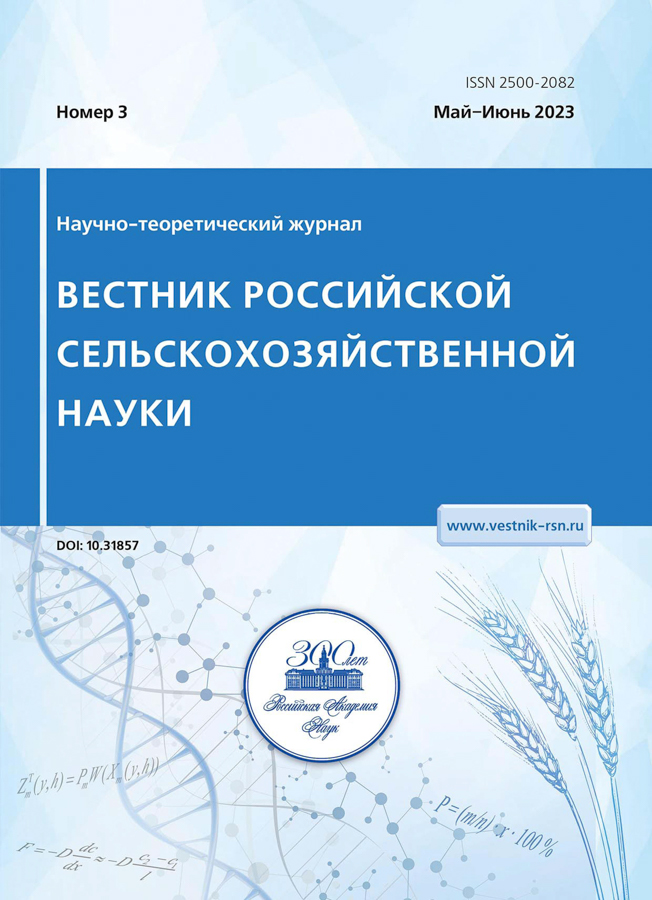Influence of agromelioration and drainage methods on the field crops productivity
- Authors: Mitrofanov Y.I1, Gulyaev M.V1, Pervushina N.K1
-
Affiliations:
- FRC �V.V. Dokuchaev Soil Science Institute
- Issue: No 3 (2023)
- Pages: 63-69
- Section: Articles
- URL: https://journals.rcsi.science/2500-2082/article/view/147906
- DOI: https://doi.org/10.31857/2500-2082/2023/3/63-69
- EDN: https://elibrary.ru/QQNTLE
- ID: 147906
Cite item
Abstract
The effectiveness of ameliorative strip loosening to a depth of 50-60 cm and volumetric soil slotting to 45-50 cm, their influence on the productivity of field crops and agrophysical properties of drained soils with different ameliorative systems (interdrainage distance of 18 and 28 m) was studied. The experiment was carried out in the period 2015-2021. at the Gubino agricultural polygon of the All-Russian Research Institute of Reclaimed Lands (Tver Region). The soil is soddy-podzolic cultivated light loamy gleyic, drained by closed pottery drainage, formed on a moraine. Volumetric slotting was carried out with a specially designed tool with filling the subarable part of the slot with crushed straw and plant residues mixed with a humus layer. Ameliorative loosening (MR) was carried out with a converted chisel plow. The pitch of slotting and MP is 140 cm. According to the generalized data, the best results on both drainage systems were obtained in the variant with volume slotting. Ameliorative loosening increased the yield of grain crops, on average over 5 years, by 0.60 t/ha (17.0%) and 0.79 t/ha (20.7%), slotting by 0.90 and 1.02 t/ha ha (25.6 and 26.7%), respectively. Additional grain harvest for the five-year period of MR action on the estimated drainage was 3.0, on sparse - 3.95 t/ha, and with volumetric slotting of the soil - 4.5 and 5.1 t/ha, respectively. On spring rapeseed, the best results were also obtained in the variant with sparse drainage and volumetric slotting of the soil. The increase in the yield of green mass in this variant, on average over 3 years, amounted to 3.6 t/ha of green mass, or 19.0%. It has been established that on soddy-podzolic light loamy gleyic soils with an atmospheric type of water supply, when designing ameliorative systems for field crop rotations, it is possible to use drainage systems with extended, compared to the calculated, interdrainage distances, which helps to reduce the cost of drainage. The use of land reclamation techniques increases the efficiency of sparse drainage.
About the authors
Yu. I Mitrofanov
FRC �V.V. Dokuchaev Soil Science Institute
Email: 2016vniimz-noo@list.ru
M. V Gulyaev
FRC �V.V. Dokuchaev Soil Science Institute
N. K Pervushina
FRC �V.V. Dokuchaev Soil Science Institute
References
- Байбеков Р.Ф. Природоподобные технологии основа стабильного развития земледелия // Земледелие. 2018. № 2. С. 5-8.6. doi: 10.24411/0044-3913-2018-10201
- Гулюк Г.Г. Эффективное развитие мелиоративного комплекса // Мелиорация и водное хозяйство. 2022. № 2. С. 2-6.
- Доспехов Б.А. Методика полевого опыта. М.: Колос, 1979. 416 с.
- Железова С.В., Мельников А.В., Беленков А.И. Урожайность озимой пшеницы и ярового ячменя на дерново-подзолистой почве при длительном применении традиционной и ресурсосберегающей обработки // Кормопроизводство. 2019. № 10. С. 14-19. 10.25685/KRM.2019.2019.41825
- Зайдельман Ф.Р. Глубокое мелиоративное рыхление почв: состояние проблемы, итоги исследований, перспективы применения и деградационные изменения // Почвоведение. 2016. № 9. С. 1131-1146.
- Кизяев Б.М., Мамаев З.М., Першина, О.Ф. Агромелиоративные мероприятия на минеральных переувлажненных землях. М.; ВНИИА, 2013. 140 с.
- Кирюшин В.И. Система научно-инновационного обеспечения технологий адаптивно-ландшафтного земледелия // Земледелие. 2022. №2. С.3-7. doi: 10.24412/0044-3913-2022-2-3-7
- Кирюшин В. И., Кирюшин С. В. Агротехнологии. СПб.: Изд-во "Лань", 2021. 464 с.
- Митрофанов Ю.И. Агрофизические основы повышения продуктивности осушаемых почв. Монография. Изд-во: LAP Lambert Academic Publishing, Германия, 2017. 196 с.
- Митрофанов Ю.И. Адаптивный подход к агромелиоративным технологиям на осушаемых землях // Мелиорация и водное хозяйство. 2013. №4. С. 25-28.
- Михайлин А.А. Глубокое рыхление мелиорируемых земель как способ повышения продуктивности сельскохозяйственных культур // Научный журнал Российского НИИ проблем мелиорации. 2012. № 4(08). С.20-31.
- Bauer V.P., Podvoisky G.L., Kotova N.E. Adaptation Strategies of the U.S. Companies to the Digitalization of Production // The world of new economy. 2018. Vol. 12. No. 2. P 78-89. doi: 10.26794/2220-6469-2018-12-2-78-89
- Trifuntova I.B. Ecological variability of the quality of oats varieties depending on vegetation conditions // IOP Conference Series: Earth and Environmental Science. 2020. Vol. 547. Article 012041. URL: https://iopscience.iop.org/article/10.1088/1755-1315/547/W12041/pdf (дата обращения: 18.01.2023). doi: 10.1088/1755-1315/547/1/012041
- Volatile-mediated suppression of plant pathogens is related to soil properties and microbial community composition / M. van Agtmaal, A. L. Straathof, A. Termorshuizen, et al. // Soil Biol. Biochem. 2018. Vol. 117. P. 164-174. doi: 10.1016/j.soilbio.2017.11.015








